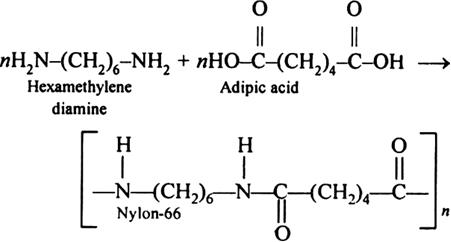ナイロン 6/6 化学特性,用途語,生産方法
定義
本品は、アジピン酸(*)とヘキサメチレンジアミンから得られるポリアミドであり、次の化学式で表される。
参照表示名称:アジピン酸
用途
衣料,産業資材
化粧品の成分用途
不透明化剤、増量剤
説明
Nylon 6,6 was first developed in 1935 by W.H. Carothers at DuPont and patented in 1938 for use as a textile fiber. It was originally given the name Fiber #66. The fibers are known to be strong, tough, and elastic. Importantly, as opposed to traditional fibers such as cotton, wool, and rayon, nylon fibers are glossy. They are extruded through a spinneret with a circular or trilobal cross section shape. Nylon 6,6 fibers can be used individually, i.e., as monofilaments, for brushes, surgical sutures, tennis strings, and fishing lines. Nylon 6,6 fibers are used for clothing, carpets, tire cords, conveyor belts, and brushes. Nylon 6,6 exhibits excellent dyeability and are twice as durable as Cotton (see Canvasetc.com). Nylon is sometimes coated with plastic, such as vinyl, to produce thin, lightweight waterproof fabrics.
化学的特性
white pellets, powder or fibre
使用
Nylon 6/6 can be used as nanofibers for the fabrication of support materials for osmosis membranes. It can also be used in the formation of the nanofibrous membranes as separators in lithium-ion batteries.
定義
Nylon-6,6 is a type of polyamide and is made of two monomers each containing 6 carbon atoms, hexamethylenediamine, and adipic acid. It is used to Fibers for textiles, brushes and sutures cable sheathing and tubing and bearings, cams, gears and casings for tools and appliances.
製造方法
Nylon 6/6 is synthesized by polycondensation of hexamethylenediamine and adipic acid with the removal of water.

一般的な説明
Nylon 6/6 is a thermoplastic material with good mechanical properties like elastic modulus (~21 MPa) and peak stress (~6.5 MPa). It also has good thermal stability and flexibility that makes it useful in the packaging of food items.
化学性质
ナイロン66は等モルのヘキサメチレンジアミンとアジピン酸からなるナイロン66塩の水溶液に,粘度安定剤など各種添加剤を加え,250?280℃で加圧から常圧にして脱水重縮合反応で製造される。
解説
絹糸のような繊維を人工的に作ることをめざし,米のデュポン社で 1927 年からカロザースがポリマ ーの合成研究を始めた.(分子が単独な状態を単量体 monomer, 2分子が合体したものが二量体 dimer, 分子が多数連結したものを多量体 polymer という).小さい分子を無限に連結させて巨大な分子を生成 する反応を重合という.カロザースは2種類の分子を反応させて交互に連結させようとしたが,重合 反応が途中で止まり,ある一定の長さを超えられない,という問題に直面した.種々検討したところ, 反応の際に生じる水分が重合を止めていることがわかった. そこで,水分を徹底的に除去することで,人工繊維の合成 に成功した.ただし,熱や薬品に弱いと商品価値はない. カロザースはさらに開発を進め,1934 年にナイロンを発明 した.それは強くて弾力性があり,高温にも耐えられる繊 維であり,ストッキングなどの商品として販売され人気を 博した. ナイロンといっても,合成原料の種類によって色々なものが できる.現在では,これらすべてをまとめてナイロンと呼ぶ. 上の図のような 2 種類の分子からなる直鎖状の脂肪族ナイロン の場合には,ジアミン成分の炭素数を前に,ジカルボン酸成分 の炭素数を後につけて区別する.上の例では炭素の数が両方と も 6 個なのでナイロン 66 と呼ばれる.欧米ではナイロン 66 が 主力であるが,日本ではナイロン 6 が主力である.

合成方法
等モルのヘキサメチレンジアミンとアジピン酸からなるナイロン66塩の水溶液に,粘度安定剤など各種添加剤を加え,250?280℃で加圧から常圧にして脱水重縮合反応で製造する。
ナイロン 6/6 上流と下流の製品情報
原材料
準備製品